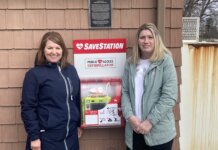This column is done by Journey to Wellness with Deborah Peddle-Hann.
It comes as no surprise that outdoor activities have picked up significantly in the last year and many of us have been out exploring all that Nova Scotia has to discover. Hiking trails, waterfalls and beaches have become common places to explore and getting outside is a perfect way to stay fit and healthy during the summer months.
If you follow me on social media, you know I have fallen in love with the seemingly never-ending outdoor beauty this province has to offer. But outdoor activities bring greater risks, and we need to ensure we are staying safe. Before you set off on your next hike, here are a few tips to keep you and your loved ones safe.
- Protection from the elements – Nova Scotia summers come with sun, wind and rain, sometimes all in the same day! This is especially true if you are hiking any of our stunning coastlines. You may be enjoying the gorgeous view when an unexpected rainstorm can roll through quickly. Make sure you wear a hat and sunscreen to protect your skin from the sun and have backup rain protection in your pack.
- Know where you are – The quickest way to ruin a walk or a hike is to get lost. I have found many Nova Scotia trails have several side trails that, if you aren’t paying attention, can quickly have you turned around. Always make sure you know where you are going by using an app like Google maps or AllTrails but be aware that you will not always have cell service. If the trail has a paper map, make sure you bring it or take a photo of a posted map and always tell someone where you are going and when you are expected back.
- Stay on marked trails. Although this appears to be the same as the second point, it is something that can’t be said enough. Most times when you hear of a serious injury, emergency rescue or worse, a hiking related death, it is because the person decided to leave the trail for better views or photo opportunities. Always obey trail signs asking you to remain on the trail. Nova Scotia coastlines are rugged and beautiful, but incredibly dangerous if not respected. Most well marked trails have beautiful look off points with signage to get that perfect photo or selfie.
- Hydrate! Make sure you bring enough water to keep you hydrated throughout your hike. If you suspect you will need more than you can carry, pack a water filter or purification tablet to ensure you have clean drinking water in the event it is warmer than you thought, or you are out longer than you thought you would be.
- Proper footwear. If you have ever had to walk with a blister or twisted ankle, you’ll know why this one makes the list. I made the mistake this spring by hiking with regular runners and although I was bruised and scraped, I was very lucky that a slip on a wet rock didn’t result in a more serious injury. If you plan to do any sort of trail walking or hiking, a good pair of hiking boots or trail runners are a must. As a bonus, carry an extra pair of dry socks in your pack.
- Be prepared for emergencies. I carry emergency food, water purification, shelter (emergency blanket) and first aid kit for every single hike I do, even if it is short and somewhere I know. Being prepared can not only make a great hike even better, but it can save your life or the life of someone else. Bonus points if you return home safely without having to use it at all.
- Know your animals. We are very fortunate that in Nova Scotia most of our wildlife is more afraid of us than we are of them! We don’t see a lot of big game wildlife while hiking because they hear us long before we arrive and will leave the area. That being said, make sure you have some knowledge of animal scat (poop) so you know what has been in the area and do your research. Generally, in Nova Scotia, making noise as you hike is all you need to do to avoid an encounter with a wild animal.
- Take a break if you start to feel clumsy. This one seems easy enough, but you would be surprised at how often you will ignore those signs of tiredness or hunger. Sometimes when you hike, especially in warm weather, you don’t necessarily feel like eating. Your stomach may not be telling you to eat but I promise you that your body needs fuel and energy. The first sign of low energy on a hike is clumsiness. When you start to find yourself tripping over rocks and stumps, dragging your feet, or feeling like you aren’t paying attention, find a place to rest, refuel and hydrate.
- Leave no trace. This is a no-brainer and should be your mantra every time you head out. Don’t leave any trace that you were there and whatever you pack in, you pack out! When you leave an area, take one last glance around. If you can tell that someone has been there, do what you can to return the area to the condition it was when you arrived for the next person to enjoy.
We are incredibly fortunate to live in one of the most naturally beautiful places on earth.
Our wilderness areas seem to go on forever and our coastline is stunning. Use an app like AllTrails to search for hiking trails in your area. I promise you will be shocked at just how many trails there are!
Pick a different trail each week, get active and enjoy!











